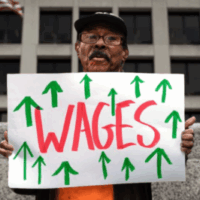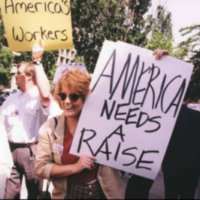56 Cities, Counties, and States Will Raise Minimum Wage Rates on January 1—Many Reaching or Exceeding $15—With Another 26 Jurisdictions to Lift Pay Later in 2022
In 2022, a record number of states and localities will increase their minimum wages—10 years after fast-food workers first went on strike to demand $15 and a union. These record increases are the result of underpaid workers organizing, demanding, and winning higher wages. This movement has not only led to the adoption of higher state and local minimum wages but has helped seed new worker activism and mobilization across our economy.
Summary of Wage Increases in 2022
On January 1, 2022 (December 31, 2021 for workers in New York), the minimum wage will increase in 21 states and 35 cities and counties. In 33 of those jurisdictions, the wage floor will reach or exceed $15 per hour for some or all employers.
Later in 2022, four additional states and 22 local jurisdictions will also lift their wage floors—17 of them to $15 or more. By the end of 2022, 49 jurisdictions (two states and 47 cities and counties) will meet or exceed a $15 minimum wage for some or all employers.
In total, 81 jurisdictions—25 states and 56 municipalities—will raise their minimum wage floors before the end of 2022. (The City of West Hollywood, CA will increase wages twice in 2022 but is counted only once in the year’s grand total.) Below is a summary of what to expect:
- Minimum wages will increase in 21 states and 35 cities and counties on or around New Year’s Day, for a total of 56 jurisdictions (Table 1).
- In two states and 31 cities and counties, the minimum wage will reach or exceed $15 per hour for some or all employers—including the State of California and the City of Hayward, CA, which will have lower minimum wages for small employers; as well as the State of New York, which previously reached a $15 minimum wage for fast-food workers throughout the state in 2021, and for all workers in New York City in 2019, as part of a statewide wage order enacted in 2016.
- In eight states and 27 cities and counties, the minimum wage will increase due to cost-of-living adjustments.
- Later in 2022, four states and 22 cities and counties will follow with additional minimum wage increases, for a total of 26 jurisdictions (Table 2).
- Among them is the City of West Hollywood, CA, which will raise its wage floor twice—on January 1st and July 1st.
- In 17 cities and counties, the minimum wage will reach or exceed $15 per hour—including the District of Columbia and 11 California localities that have already reached or surpassed a $15 minimum wage and are expected to raise wages further to account for inflation; and four localities in Illinois, Maryland, and Minnesota, which will have lower minimum wages for certain employers (see footnote vi at the end of Table 2).
- In 17 cities and counties, the minimum wage will increase due to cost-of-living adjustments, including Chicago, IL and Montgomery County, MD, both of which reached a $15 minimum wage for large employers in 2021 and will adjust this rate in 2022 to account for inflation.
- 44 cities and counties will have surpassed a $15 minimum wage for some or all employers at some point in 2022. (See Table 3).
Context: Fight for $15 and COVID-19 pandemic have forced a reckoning in low-paying industries, with workers demanding and winning more
November 2022 will mark the 10-year anniversary of the Fight for $15. This worker-of-color-led movement has had a significant impact on wages, and has influenced policy debates and the public conversation about fair pay and workplace rights. In the first nine years since its founding, the Fight for $15 has resulted in $150 billion in higher pay for 26 million workers.[1]
But the movement’s impact does not stop there. The COVID-19 pandemic has forced a reckoning in low-wage industries and throughout the economy. Low pay, a lack of job security, and poor working conditions are endemic in service and other frontline jobs,[2] with disproportionate effects on Black women, Latinas, and Asian Americans of any gender.[3]
The pandemic has exposed for the public the depth of the precarity experienced by underpaid workers. And workers—fed up with low pay, lack of respect, and facing workplace exposure to a deadly virus—have been emboldened to act collectively and individually to demand change. Some workers—in particular, those in the restaurant industry—have expressed their discontent by quitting in large numbers,[4] perhaps permanently,[5] citing low pay as one of the top reasons for leaving.[6] Others have gone on strike, engaged in slowdowns or sick-ins, or taken other action.[7]
Legacy of the Fight for $15
An increasing number of employers are responding to the mass resignations by offering higher starting wages—often $15 and above[8]—in hopes of attracting and retaining workers. (For a sample list of employers that have raised wages to $15 or more during the pandemic, see Table 4 below. For a list of employers that have raised wages at any point since 2012, see Appendix Table I of the NELP report, Quantifying the Impact of the Fight for $15.[9]) This suggests that, despite previous claims about the unaffordability of higher wages, many employers have always been able to pay more but chose not to do so.
The $15 figure being offered by employers today is not a mere coincidence, but is the wage floor demanded by fast-food and other underpaid workers leading the Fight for $15. These demands have directly led to $150 billion of additional pay for 26 million workers, half of whom are women, and many of whom are also workers of color (46 percent).[10]
Looking Forward
Although workers have made tremendous gains since 2012, there is still much to be done. Twenty states have refused to raise their wage floors above the federal rate for over a decade. Roughly half of those states are located in the U.S. South, where a majority of Black workers live,[11] and where, not surprisingly, they experience higher levels of poverty[12] and downward economic mobility.[13]
The federal wage floor has been stuck at $7.25 per hour since 2009—the longest stretch since the adoption of a minimum wage in 1938. The federal tipped wage has been frozen at $2.13 for even longer, since 1991. Absent state action to raise the minimum wage, underpaid workers in states that are pegged to the federal minimum wage rates will have to continue to depend on Congress to see a raise in their hourly wages. The ongoing efforts to raise the federal wage floor[14] are therefore critical; as are possible ballot initiatives in Nebraska, Idaho, and California, which will give voters a chance to approve $15 to $18 minimum wages during the 2022 midterm elections.
Download the report to read more.
Endnotes
[1]. Yannet Lathrop, T. William Lester and Matthew Wilson, Quantifying the Impact of the Fight for $15: $150 Billion in Raises for 26 Million Workers, With $76 Billion Going to Workers of Color, National Employment Law Project, July 2021, https://www.nelp.org/publication/quantifying-the-impact-of-the-fight-for-15-150-billion-in-raises-for-26-million-workers-with-76-billion-going-to-workers-of-color/.
[2]. See Celine McNicholas and Margaret Poydock, Who are Essential Workers? A Comprehensive Look at their Wages, Demographics, and Unionization Rates, Economic Policy Institute, May 19, 2020, https://www.epi.org/blog/who-are-essential-workers-a-comprehensive-look-at-their-wages-demographics-and-unionization-rates/; Molly Kinder and Laura Stateler, Essential Workers Comprise About Half of All Workers in Low-Paid Occupations. They Deserve a $15 Minimum Wage, Brookings, February 5, 2021, https://www.brookings.edu/blog/the-avenue/2021/02/05/essential-workers-deserve-minimum-wage-increase/; and Xavier de Souza Briggs and Russell Jackson, How a $15 Minimum Wage Could Help Restaurants and Other Hard-Hit Small Businesses, Brookings, February 22, 2021, https://www.brookings.edu/blog/the-avenue/2021/02/22/how-a-15-minimum-wage-could-help-restaurants-and-other-hard-hit-small-businesses/.
[3]. Elise Gould and Melat Kassa, “Low-wage, low-hours workers were hit hardest in the COVID-19 recession,” The State of Working America 2020, Economic Policy Institute, May 20, 2021, https://www.epi.org/publication/swa-2020-employment-report/.
[4]. Compare April 2020 and July 2021 JOLTS (Job Openings and Labor Turnover Survey) figures, for example, which show a nearly 227 percent increase in quits in the food and accommodations industry—from a low of 225,000 in April 2020, to 735,000 in July 2021. See Bureau of Labor Statistics, Job Openings and Labor Turnover Survey News Release, September 9, 2020, https://www.bls.gov/news.release/archives/jolts_09092020.htm, and October 12, 2021, https://www.bls.gov/news.release/archives/jolts_10122021.htm.
[5]. See Andrew Chamberlain, Restaurant Workers Explore Careers in New Industries During COVID-19, Glassdoor, May 27, 2020, https://www.glassdoor.com/research/restaurant-server-new-jobs/; Peter Romeo, “Brace Yourself for a Mass Exodus of Employees,” Restaurant Business, October 7, 2021, https://www.restaurantbusinessonline.com/workforce/brace-yourself-mass-exodus-employees; and Lisa Jennings, Four Reasons Workers are Staying Away from the Restaurant Industry and What You Can Do About It, Nation’s Restaurant News, August 23, 2021, https://www.nrn.com/workforce/four-reasons-workers-are-staying-away-restaurant-industry-and-what-you-can-do-about-it.
[6]. One Fair wage, It’s a Wage Shortage, Not a Worker Shortage, May 2021, https://onefairwage.site/wp-content/uploads/2021/05/OFW_WageShortage_F.pdf.
[7]. Luis Feliz Leon and Maximillian Alvarez, “Viewpoint: Beneath Striketober Fanfare, The Lower Frequencies of Class Struggle,” Labor Notes, October 29, 2021, https://labornotes.org/2021/10/viewpoint-beneath-striketober-fanfare-lower-frequencies-class-struggle.
[8]. Christopher Rugaber, “$15 Wage Becoming a Norm as Employers Struggle to Fill Jobs,” Associated Press, July 27, 2021, https://apnews.com/article/business-health-coronavirus-pandemic-minimum-wage-940a6a7530d734242c6f384b751b8033.
[9]. Yannet Lathrop, T. William Lester and Matthew Wilson, op. cit.
[10]. Ibid.
[11]. Christine Tamir, The Growing Diversity of Black America, Pew Research Center, March 25, 2021, https://www.pewresearch.org/socialtrends/2021/03/25/the-growing-diversity-of-black-america/.
[12]. Roger Moore, Poverty Statistics for Southern States, The Southern Legislative Conference, September 2018, https://www.slcatlanta.org/research/index.php?pub=580.
[13]. Olugbenga Ajilore, 3 Ways to Improve the Outcomes for African Americans in the Rural South, Center for American Progress, August 6, 2019, https://www.americanprogress.org/issues/economy/reports/2019/08/06/470913/3-ways-improve-outcomes-african-americans-rural-south/.
[14]. Congress.gov. “Text – S.53 – 117th Congress (2021-2022): Raise the Wage Act of 2021.” January 26, 2021. https://www.congress.gov/bill/117thcongress/senate-bill/53/text.




